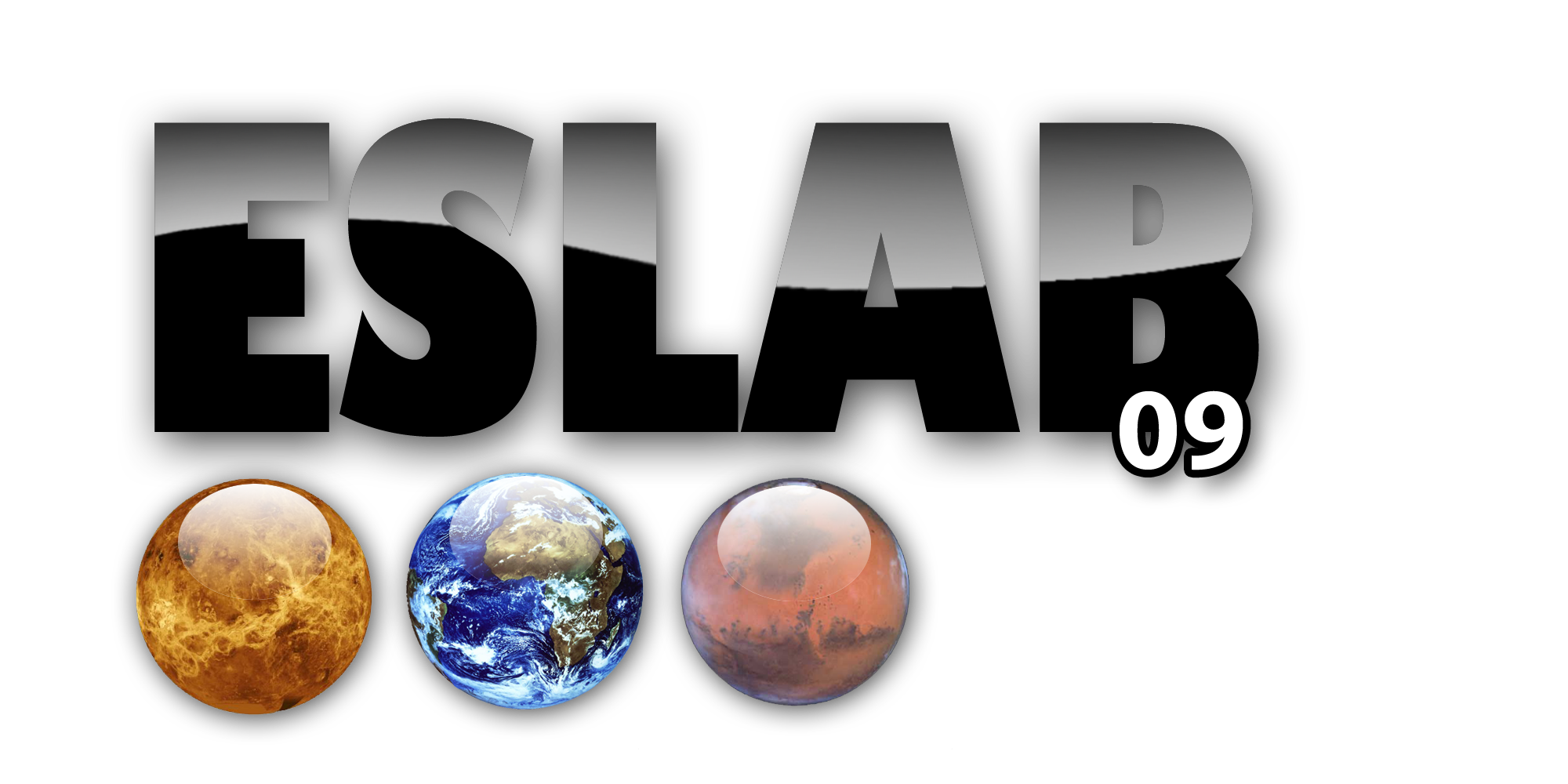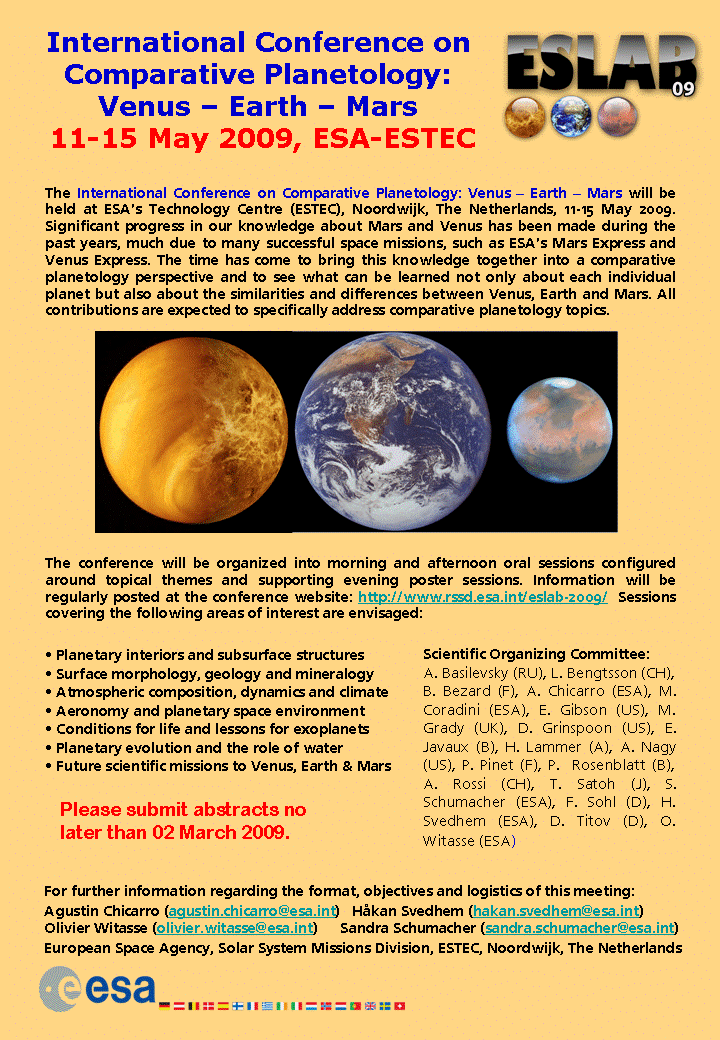ESLAB 2009 - Conferences Archive
43rd ESLAB Symposium

International Conference on Comparative Planetology:
Venus - Earth - Mars
11-15 May 2009
ESTEC, Noordwijk (NL)
Download of conference presentations:
Session 1: Interior and subsurface
Session 2: Geology, surface chemistry and mineralogy
Session 3: Conditions for life
| Main Author | Title | Type of presentation |
| Houtkooper | Glaciopanspermia: Seeding the Terrestrial Planets with Life? | Poster |
Session 4: Atmospheric chemistry and clouds
Session 5: Climate and atmospheric dynamics
Session 6: Aeronomy and solar wind interaction
Session 7: Evolution
| Main Author | Title | Type of presentation |
| Morschhauser | Mantle degassing and atmospheric evolution: an application to Mars and Venus | Poster |
Session 8: Future missions
When and where:
The International Conference on Comparative Planetology: Venus - Earth - Mars, will be held 11 - 15 May 2009, at the ESTEC establishment of ESA in Noordwijk, The Netherlands.
Purpose:
The aim of this conference is to identify and discuss the similarities and differences between the terrestrial planets Venus, Earth and Mars. In recent years, through space missions our knowledge of Mars and Venus has increased significantly. At the same time a fleet of spacecraft observing the Earth has led to an improved understanding of our home planet in a large number of fields. Until now this knowledge has only been applied to each individual planet while the question what we can learn about the similarities and differences between Venus, Earth and Mars has generally not been addressed. Now special attention will be given to comparisons between the different planets to fully exploit the benefits of our newly gained knowledge.
Venus, Earth and Mars are all unique in their own ways but as terrestrial planets they also share several common features. It is therefore intriguing to analyze the different evolutionary paths these planets took despite their partly comparable initial conditions. Earth and Venus, for example, have nearly the same size and density but their atmospheres are completely different and their tectonic behaviour differs significantly. How can these differences be explained given their basic similarities? Why does Earth still have a magnetic field while Venus and Mars have not? Why does the Earth have oceans while Mars and Venus have not? These are just a few examples of questions that will be addressed during the conference.
The conference will embrace all topics relevant to the past, present and future state of Venus, Earth and Mars thereby encouraging a truly interdisciplinary discussion between researchers with a large variety of expertise. The results may have implications for both an improved understanding of the evolution of each of these three planets but also for a more general understanding of the evolution of planetary systems. This will be of great general interest but will also help answering the questions which undoubtedly will arise with the detection of an Earth-like planet outside our Solar System.
Scope:

- Interior and subsurface
- Geology
- Surface chemistry and mineralogy
- Atmospheric chemistry and clouds
- Atmospheric dynamics and climate
- Aeronomy and solar wind interaction
- Planetary evolution
- Conditions for life
- Future missions
(click image to download poster)
Presentations:
Keynote oral presentations are planned to last 30 minutes. Contributed oral presentations are planned to last 20 minutes including a short discussion. A Windows PC will be used in the conference room. If your presentation is prepared on a Mac, please check the compatibility with a PC before uploading it.
The maximum available space for posters will be: 180 cm (height) x 120 cm (width).
Programme:
The conference programme can be downloaded here .
Scientific Organizing Committee:
The international Scientific Committee of the conference is composed of:
- Alexander Basilevsky, Vernadsky Institute, Moscow, Russia
- Lennart Bengtsson, University of Reading, Reading, United Kingdom
- Bruno Bezard, Observatoire de Paris-Meudon, Paris, France
- Agustin Chicarro, European Space Agency, Noordwijk, The Netherlands
- Marcello Coradini, European Space Agency, Paris, France
- David Crisp, JPL, Pasadena, USA
- Everett Gibson, NASA Johnson Space Center, Houston, USA
- Monica Grady, Open University, Milton Keynes, United Kingdom
- David Grinspoon, Denver Museum of Nature and Science, Denver, USA
- Emmanuelle Javaux, University of Liège, Liège, Belgium
- Helmut Lammer, Space Research Institute, Graz, Austria
- Andrew Nagy, University of Michigan, Ann Arbor, USA
- Patrick Pinet, Centre National d'Etudes Spatiales, Toulouse, France
- Pascal Rosenblatt, Royal Observatory of Belgium, Brussels, Belgium
- Angelo Pio Rossi, International Space Science Institute, Bern, Switzerland
- Takehiko Satoh, JAXA, Tokyo, Japan
- Sandra Schumacher, European Space Agency, Noordwijk, The Netherlands
- Frank Sohl, German Aerospace Center, Berlin, Germany
- Håkan Svedhem, European Space Agency, Noordwijk, The Netherlands
- Dimitri Titov, Max-Planck-Institut für Sonnensystemforschung, Kathlenburg-Lindau, Germany
- Olivier Witasse, European Space Agency, Noordwijk, The Netherlands
Proceedings:
During and after the conference the presentations will be posted on the web. In case of sensitive material it will be possible to provide an edited version of the presentation for web publication.
Papers presented at the conference will be published in a dedicated issue of an international scientific journal under full peer review. Negotiations are not yet finalised.
Schedule:
| Deadline for abstract submission and application to travel grants | - | 02 March 2009 |
| Final Announcement on website with program for oral & pster sessions | - | Late March 2009 |
| Abstracts posted on the web | - | Late March 2009 |
| Deadline for early registration with reduced fee | - | 10 April 2009 |
| Conference | - | 11-15 May 2009 |
| Presentations posted on the web | - | During and after conference |
| Deadline for journal submission | - | Autumn 2009 |
Presentations available on-line:
All presentations (pdf files) will be posted on the conference website after each session to foster collaboration among participants and keep a comprehensive record of the conference for future reference. Therefore, all presenters are expected to provide their presentations (PowerPoint only) to the organizers. In case of sensitive material the presentation can be edited.
Local Organizing Committee:
- Clare Bingham
- Agustin Chicarro
- Sandra Schumacher
- Håkan Svedhem
- Olivier Witasse
- Removed a total of (1) style text-align:center;
- Removed a total of (1) style float:left;
- Removed a total of (13) align=center.
- Removed a total of (40) align=left.
- Removed a total of (5) border attribute.








































 Sign in
Sign in
 Science & Technology
Science & Technology